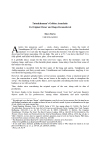Akhenaten
« Deux mentions du prænomen d’AkhĂ©naton dans une encyclopĂ©die byzantine du Xe siècle »
ENiM 5, 2012, p. 115-117.
 L’encyclopédie byzantine de Suidas (Souda), du Xe siècle, nous offre, sous la forme « Nephersôphris », la seule attestation connue du prænomen d’Akhénaton dans les sources grecques. Cette mention de l’hérétique en plein Moyen-Âge, prenant l’aspect d’un court proverbe évoquant sa légende noire, prouve que le souvenir du pharaon d’Amarna avait bel et bien survécu, de manière obscure, à travers plus de deux mille ans d’histoire.
L’encyclopédie byzantine de Suidas (Souda), du Xe siècle, nous offre, sous la forme « Nephersôphris », la seule attestation connue du prænomen d’Akhénaton dans les sources grecques. Cette mention de l’hérétique en plein Moyen-Âge, prenant l’aspect d’un court proverbe évoquant sa légende noire, prouve que le souvenir du pharaon d’Amarna avait bel et bien survécu, de manière obscure, à travers plus de deux mille ans d’histoire.
 The Suda, a 10th century Byzantine encyclopedia, provides us with the only mention of Akhenaten’s praenomen in Greek sources (Nephersophris = Neferkheperura). This evocation of the heretical king, in the shape of a proverb focusing on the unlucky power of his name, proves that Akhenaten’s dark memory had survived by some unknown ways, over more than 2000 years.
The Suda, a 10th century Byzantine encyclopedia, provides us with the only mention of Akhenaten’s praenomen in Greek sources (Nephersophris = Neferkheperura). This evocation of the heretical king, in the shape of a proverb focusing on the unlucky power of his name, proves that Akhenaten’s dark memory had survived by some unknown ways, over more than 2000 years.
 Consulter cet article (39614) -
Consulter cet article (39614) -  Télécharger cet article au format pdf (22356)
Télécharger cet article au format pdf (22356)
« Un jardin au petit temple d’Aton de Tell el-Amarna ? »
ENiM 6, 2013, p. 205-231.
 Cet article présente l’hypothèse selon laquelle il aurait existé devant le petit temple d’Aton, une cour arborée agrémentée d’un bassin en forme de T renversé, aménagement démantelé pour laisser place sous le règne d’Ânkhkhépérourê au supposé Coronation Hall dit de « Smenkhkarê ».
La démonstration se fonde sur deux études comparées dont les résultats ont été confrontés : celle des scènes de remise de « l’or de la récompense » aux fonctionnaires méritants par Akhénaton et Néfertiti et celle des représentations architecturales de temples dans les tombes amarniennes avec les plans des monuments de culte atoniste eux-mêmes et les faits archéologiques.
L’article s’achève par un essai de reconstitution de cet état supposé du petit temple illustré par des modèles numériques.
Cet article présente l’hypothèse selon laquelle il aurait existé devant le petit temple d’Aton, une cour arborée agrémentée d’un bassin en forme de T renversé, aménagement démantelé pour laisser place sous le règne d’Ânkhkhépérourê au supposé Coronation Hall dit de « Smenkhkarê ».
La démonstration se fonde sur deux études comparées dont les résultats ont été confrontés : celle des scènes de remise de « l’or de la récompense » aux fonctionnaires méritants par Akhénaton et Néfertiti et celle des représentations architecturales de temples dans les tombes amarniennes avec les plans des monuments de culte atoniste eux-mêmes et les faits archéologiques.
L’article s’achève par un essai de reconstitution de cet état supposé du petit temple illustré par des modèles numériques.
 This article presents the hypothesis that there was a leafy courtyard with a pool in the shape of an inverted T in front of the small Aten temple. Under the reign of Ă‚nkheperurĂŞ, this courtyard may have been dismantled to make way for the presumed Coronation Hall also known as SmenkhkarĂŞ Hall.
The demonstration is based on two comparative studies: between the rewarding scenes which show the distribution of the « gold of honour » by Akhenaten and Nefertiti, and between the architectural representations of temples from the Amarna tombs with the plans of the Aten temples themselves and archaeological facts.
The article ends with an attempt to rebuild this supposed state of the Small Aten temple by means of digital models.
This article presents the hypothesis that there was a leafy courtyard with a pool in the shape of an inverted T in front of the small Aten temple. Under the reign of Ă‚nkheperurĂŞ, this courtyard may have been dismantled to make way for the presumed Coronation Hall also known as SmenkhkarĂŞ Hall.
The demonstration is based on two comparative studies: between the rewarding scenes which show the distribution of the « gold of honour » by Akhenaten and Nefertiti, and between the architectural representations of temples from the Amarna tombs with the plans of the Aten temples themselves and archaeological facts.
The article ends with an attempt to rebuild this supposed state of the Small Aten temple by means of digital models.
 Consulter cet article (43434) -
Consulter cet article (43434) -  Télécharger cet article au format pdf (21632)
Télécharger cet article au format pdf (21632)
« Tutankhamun’s Golden Armchair: Its Original Owner and Shape Reconsidered »
ENiM 14, 2021, p. 273-284.
 Il est généralement admis que le fauteuil doré léontocéphale de la tombe de Toutânkhamon a été fabriqué pour ce roi, au début de son règne. Cependant, certains auteurs, qui ont étudié la scène atonienne sur le dossier, pensent que le siège a appartenu à un précédent roi amarnien. Dans cette étude, nous proposons deux nouvelles analyses afin d’identifier le propriétaire originel : le contexte typologique et l’iconographie globale. Ces deux approches nous permettent également de reconsidérer la forme originelle du siège. Nous démontrons ainsi que le fauteuil léontocéphale de Toutânkhamon a appartenu à un précédent roi, probablement Akhenaton, et qu’il s’agissait d’une simple chaise léonine, typique de la période amarnienne.
Il est généralement admis que le fauteuil doré léontocéphale de la tombe de Toutânkhamon a été fabriqué pour ce roi, au début de son règne. Cependant, certains auteurs, qui ont étudié la scène atonienne sur le dossier, pensent que le siège a appartenu à un précédent roi amarnien. Dans cette étude, nous proposons deux nouvelles analyses afin d’identifier le propriétaire originel : le contexte typologique et l’iconographie globale. Ces deux approches nous permettent également de reconsidérer la forme originelle du siège. Nous démontrons ainsi que le fauteuil léontocéphale de Toutânkhamon a appartenu à un précédent roi, probablement Akhenaton, et qu’il s’agissait d’une simple chaise léonine, typique de la période amarnienne.
 It is often admitted that the lion-headed golden armchair from the tomb of Tutankhamun was made for this king, at the beginning of his reign. However, some authors, who studied the Atenist scene on the backrest, think the seat belonged to a previous Amarna king. In this study, we propose two more analyses in order to identify the original owner of the armchair: the typological context and the global iconography. These two approaches allow us to reconsider the original shape of the seat, too. We show that Tutankhamun’s lion-headed armchair belonged to a previous king, most probably Akhenaten, and that it was a simple lion-legged chair, typical of the Amarna period.
It is often admitted that the lion-headed golden armchair from the tomb of Tutankhamun was made for this king, at the beginning of his reign. However, some authors, who studied the Atenist scene on the backrest, think the seat belonged to a previous Amarna king. In this study, we propose two more analyses in order to identify the original owner of the armchair: the typological context and the global iconography. These two approaches allow us to reconsider the original shape of the seat, too. We show that Tutankhamun’s lion-headed armchair belonged to a previous king, most probably Akhenaten, and that it was a simple lion-legged chair, typical of the Amarna period.
 Consulter cet article (30525) -
Consulter cet article (30525) -  Télécharger cet article au format pdf (14661)
Télécharger cet article au format pdf (14661)
ENiM 18 - 2025
4 article(s) - 11 mars 2025.
ENiM 1 à 18 (2008-2025) : 223 articles
4 023 054 téléchargements
8 341 972 consulations.
Index des auteurs

Mots clés

Derniers articles : 
Robert Steven Bianchi
Duplication and Continuity
(ENiM 18, p. 13-36 — 11 mars 2025) 
Frédéric Mougenot
Rénénoutet à la porte de la maison
(ENiM 18, p. 1-12 — 29 janvier 2025) 
CENiM - Mise en ligne des volumes Ă©puisĂ©s : 
 Anne-Sophie von BOMHARD DĂ©cans Ă©gyptiens, CENiM 23, Montpellier, 2020 — (2020)
Anne-Sophie von BOMHARD DĂ©cans Ă©gyptiens, CENiM 23, Montpellier, 2020 — (2020) 
 Jean-Claude Grenier L'Osiris ANTINOOS, CENiM 1, Montpellier, 2008 — (26 dĂ©cembre 2008)
Jean-Claude Grenier L'Osiris ANTINOOS, CENiM 1, Montpellier, 2008 — (26 dĂ©cembre 2008) 
TDENiM - Mise en ligne des volumes Ă©puisĂ©s : 
 Twitter
Twitter 3617332 visites - 10963 visite(s) aujourd’hui - 44 connecté(s)
© ENiM - Une revue d’égyptologie sur internet
Équipe Égypte Nilotique et Méditerranéenne - UMR 5140 - « Archéologie des Sociétés Méditerranéennes » (Cnrs) - Université Paul Valéry - Montpellier III
























 Contact
Contact
 Abonnez-vous !
Abonnez-vous ! Équipe Égypte Nilotique et Méditerranéenne
Équipe Égypte Nilotique et Méditerranéenne UMR 5140 « Archéologie des Sociétés Méditerranéennes » (Cnrs)
UMR 5140 « Archéologie des Sociétés Méditerranéennes » (Cnrs) Université Paul Valéry - Montpellier III
Université Paul Valéry - Montpellier III